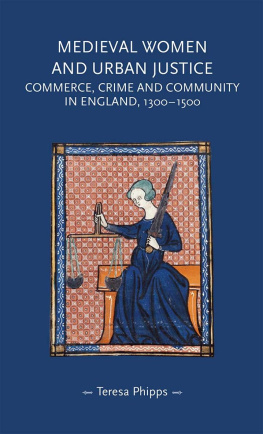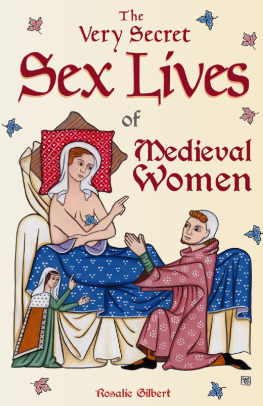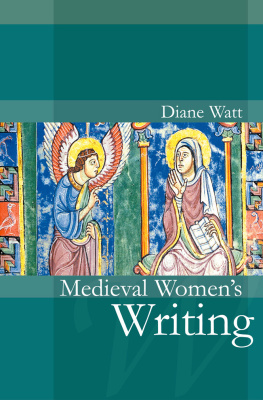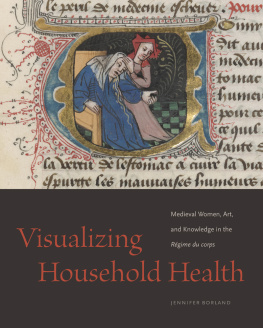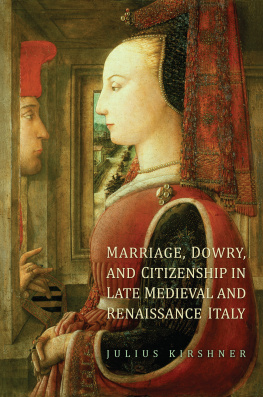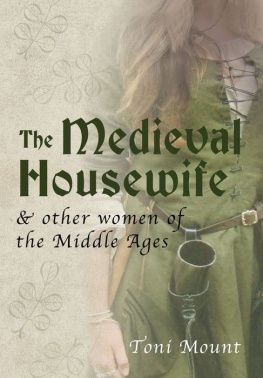Women in the Medieval Common Law c.12001500
This book examines the view of women held by medieval common lawyers and legislators, and considers medieval womens treatment by and participation in the processes of the common law. Surveying a wide range of points of contact between women and the common law, from their appearance (or not) in statutes, through their participation (or not) as witnesses, to their treatment as complainants or defendants, it argues for closer consideration of women within the standard narratives of classical legal history, and for re-examination of some previous conclusions on the relationship between women and the common law. It will appeal to scholars and students of medieval history, as well as those interested in legal history, gender studies and the history of women.
Gwen Seabourne is Professor of Legal History in the School of Law, University of Bristol, UK. She specialises in medieval legal history, and has written on medieval crime, economic regulation and medieval women.
Studies in Medieval History and Culture
Recent titles include
From Justinian to Branimir
The Making of the Middle Ages in Dalmatia
Danijel Dino
The Triumph of an Accursed Lineage
Kingship in Castile from Alfonso X to Alfonso XI (12521350)
Fernando Arias Guilln
Franks and Lombards in Italian Carolingian Texts
Memories of the Vanquished
Luigi Andrea Berto
The Bible and Jews in Medieval Spain
Norman Roth
The Cursed Carolers in Context
Edited by Lynneth Miller Renberg and Bradley Phillis
Women in the Medieval Common Law c.12001500
Gwen Seabourne
Jews and Converts in Late Medieval Castile
Breaking with the Past
Cecil D. Reid
Mobile Saints
Relic Circulation, Devotion, and Conflict in the Central Middle Ages
Kate M. Craig
For more information about this series, please visit: https://www.routledge.com/Studies-in-Medieval-History-and-Culture/book-series/SMHC
First published 2021
by Routledge
2 Park Square, Milton Park, Abingdon, Oxon OX14 4RN
and by Routledge
52 Vanderbilt Avenue, New York, NY 10017
Routledge is an imprint of the Taylor & Francis Group, an informa business
2021 Gwen Seabourne
The right of Gwen Seabourne to be identified as author of this work has been asserted by her in accordance with sections 77 and 78 of the Copyright, Designs and Patents Act 1988.
All rights reserved. No part of this book may be reprinted or reproduced or utilised in any form or by any electronic, mechanical, or other means, now known or hereafter invented, including photocopying and recording, or in any information storage or retrieval system, without permission in writing from the publishers.
Trademark notice: Product or corporate names may be trademarks or registered trademarks, and are used only for identification and explanation without intent to infringe.
British Library Cataloguing-in-Publication Data
A catalogue record for this book is available from the British Library
Library of Congress Cataloging-in-Publication Data
A catalog record has been requested for this book
ISBN: 978-1-4724-3980-2 (hbk)
ISBN: 978-0-3677-4522-6 (pbk)
ISBN: 978-1-315-54672-8 (ebk)
Typeset in Times New Roman
by codeMantra
To my mother, Margot Seabourne,
who, in my own deep past,
took me to countless castles and cathedrals,
shared her gloves on cold days
and always had a spare sweet for the sermon;
with love and thanks for a lifetime of care, conversation, inspiration
and general magnificence.
Part I
Unions and divisions
A rather unlauded work on women and law, Arthur Rackham Clevelands Woman under the English Law of 1896 pronounced that every nation which has attained to such a degree of civilization as to have reduced its system of jurisprudence to writing made distinctions in its laws between women and the general body of the people owing obedience to these laws. There was, Cleveland opined, no exception to this rule, and nor was it possible to imagine any state of society composed of men and women, whose system of jurisprudence could be such, that the same laws would apply equally to the two sexes. In setting out separate laws for men and women, lawgivers in all past ages were not making a choice, but recognising an eternal fact: the legal status of woman was of necessity different from that of man.1
This passage might emphasise division of laws applicable to men and women as clear and fundamental throughout history, but the works of contemporaries more influential on the nascent classical legal history tradition had a different perspective, emphasising divisions between women, generally on the basis of marital status, and pre-eminently in the context of rights over land rather than presenting women as a coherent, separate, legal category. In modern historical study too, questions are asked about treating the women of past periods as a unified category, with frequent emphasis on divisions amongst them, in terms of life-cycle-stage or social position, and on the complexity of historical (and contemporary) ideas of sex and gender categorisation, in line with ideas of identity and intersectionality with which modern scholarship has been enriched.2 The category women is also the subject of considerable current legal and political controversy.3
Cleveland, Woman under the English Law, pp. iii, vi. On its reception, see Times, Friday, 4th September, 1896, p. 6.
See, e.g., Patricia Skinner, Studying Gender in Medieval Europe: Historical Approaches (London, 2018); Joan W. Scott, Gender: a Useful Category of Historical Analysis, AHR 91 (1986), 105375; Elisabeth van Houts, Introduction, in Medieval Memories: Men, Women and the Past, 7001300, ed. by Elisabeth van Houts (London and New York, 2013), p. 2; Seabourne, IMW, pp. 1012; Pauline Stafford, Women and the Norman Conquest, TRHS 6 ser. IV (1994), 22149, 230; Kimberl Williams Crenshaw, Mapping the Margins: Intersectionality, Identity Politics, and Violence against Women of Color, Stanford Law Review 43 (1991), 124199; S.H. Rigby, English Society in the Later Middle Ages: Class, Status and Gender (London, 1995).
See, e.g., R. on the application of Harry Miller v. The College of Policing and the Chief Constable of Humberside [2020] EWHC 225 (Admin); Alex Sharpe, Will Gender Self-Declaration Undermine Womens Rights and Lead to an Increase in Harms?, MLR 83 (2020), 53957; Alessandra Asterti and Rebecca Bull, Gender Self-Declaration and Womens Rights: How Self-Identification Undermines Womens Rights and Will Lead to an Increase in Harms: A Reply to Alex Sharpe, MLR comment: https://www.modernlawreview.co.uk/asteriti-bull-sharpe/ Accessed 25th July, 2020. On sex/gender in legal scholarship, at a more theoretical level, see, e.g., Joanne Conaghan, Law and Gender (Oxford, 2013).
As far as a consideration of the medieval common law is concerned, however, while we must certainly take account of separate provision for different groups of women and the possibility of fluidity of ideas around gender, it should be noted that differentiation between men and women was treated as fundamental in the common law system. It is also clear that the existence of rules for one group of women could have an impact on the lives and legal treatment of other groups, so that it is important to question statements which treat the legal situation of the married woman as something entirely separable from the situation of women as such.4 An insistence on considering married and unmarried women separately allows for an unbalanced description of the legal picture, for example positing a rule of womens full rights in private law, with the considerable disabilities of the married woman diminished as an exception, however extensive the impact of those exceptional disabilities might have been,5 or presenting the unlimited and limited positions of women at different stages or in different situations as being in some sort of balance, as can be seen in a comment by C.T. Flower in a Selden Society volume from the 1940s:


